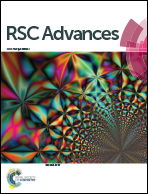“Green” nano-filters: fine nanofibers of natural protein for high efficiency filtration of particulate pollutants and toxic gases†
Abstract
Particulate and chemical pollutants are ubiquitous in polluted air. However, current air filters using traditional polymers can only remove particles from the polluted air. To efficiently filter both particulates and chemical pollutants, development of multi-functional air filter materials with environmental friendness is critically needed. In this study, gelatin is employed as an example to study the potential of natural proteins as high-performance air-filtering material. Based on an optimized composition of a “green” solvent, uniform gelatin nanofiber mats were fabricated via an electrospinning approach. For the first time, it is found that the resulting nanofabrics possess extremely high removal efficiencies for both particle matter (with a broad range of size from 0.3 μm to 10 μm) and various toxic chemicals (e.g. HCHO and CO). Moreover, these high efficiencies are realized by the protein nanofabrics with a much lower areal density (3.43 g m−2) when compared with that of commercial air filters (e.g. 164 g m−2 for high efficiency particulate air filter (HEPA)). This study reveals that nanofabrics of natural proteins hold great potential for application in “green” and multi-functional air filtering materials.


 Please wait while we load your content...
Please wait while we load your content...